UK Macroeconomic Policies: Fiscal and Monetary Strategies in Detail
VerifiedAdded on 2023/06/18
|19
|2631
|475
Report
AI Summary
This report provides a comprehensive analysis of macroeconomic policies in the UK, focusing on fiscal and monetary strategies. It explains the implementation of fiscal policy through taxes, public expenditure deficits, and public debt sustainability, alongside the implementation of monetary policy through open market operations, reserve requirements, and interest rate policies. The report highlights the differences between fiscal and monetary policies, their effects on GDP and price levels, and the factors influencing money demand. It also discusses discretionary and non-discretionary policies and unprecedented fiscal measures taken during recessions in the UK, including actions by the Bank of England to support the economy. The analysis emphasizes the importance of these policies in managing economic growth, unemployment, and inflation, providing a detailed overview of the UK's approach to macroeconomic stability. Desklib provides students access to similar solved assignments and resources for academic support.
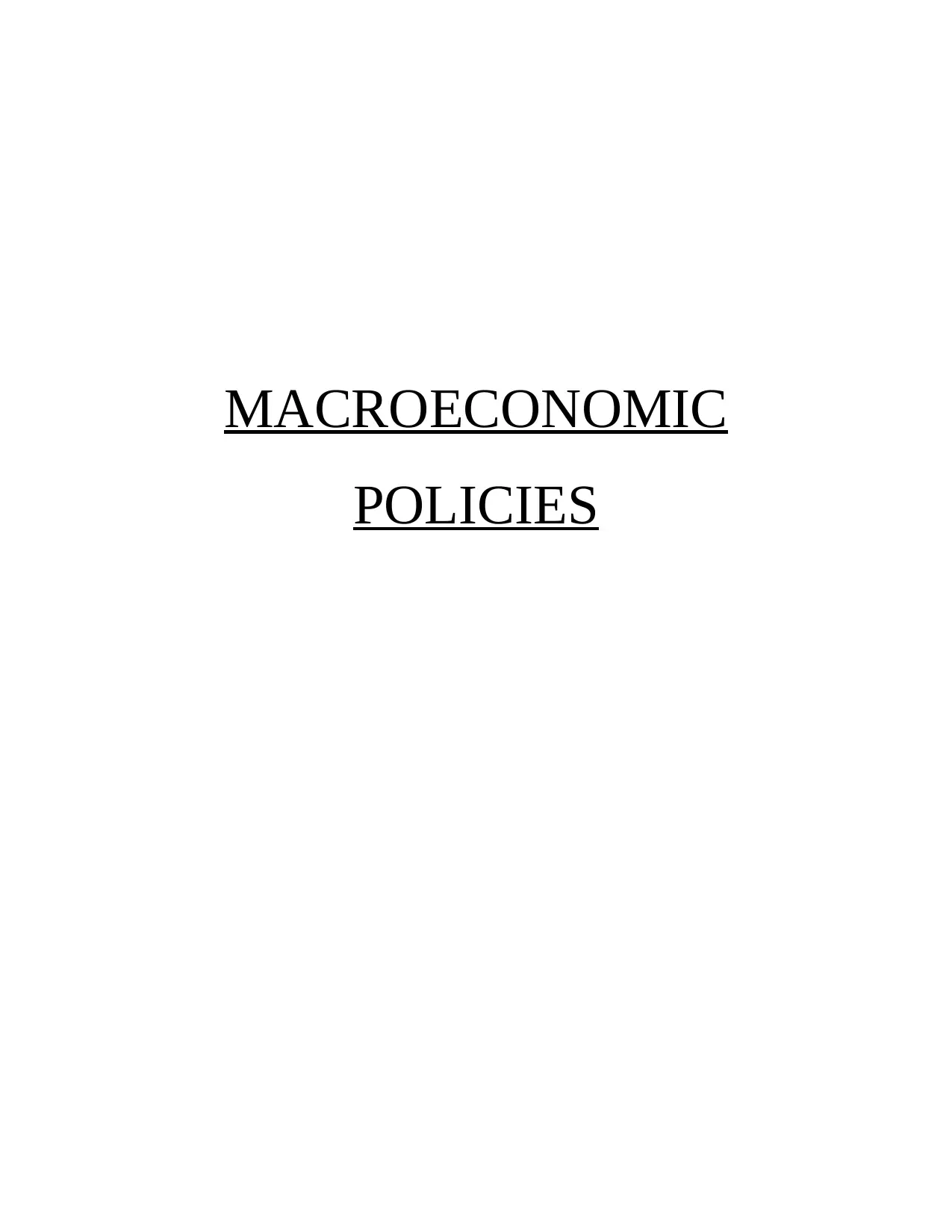
MACROECONOMIC
POLICIES
POLICIES
Paraphrase This Document
Need a fresh take? Get an instant paraphrase of this document with our AI Paraphraser
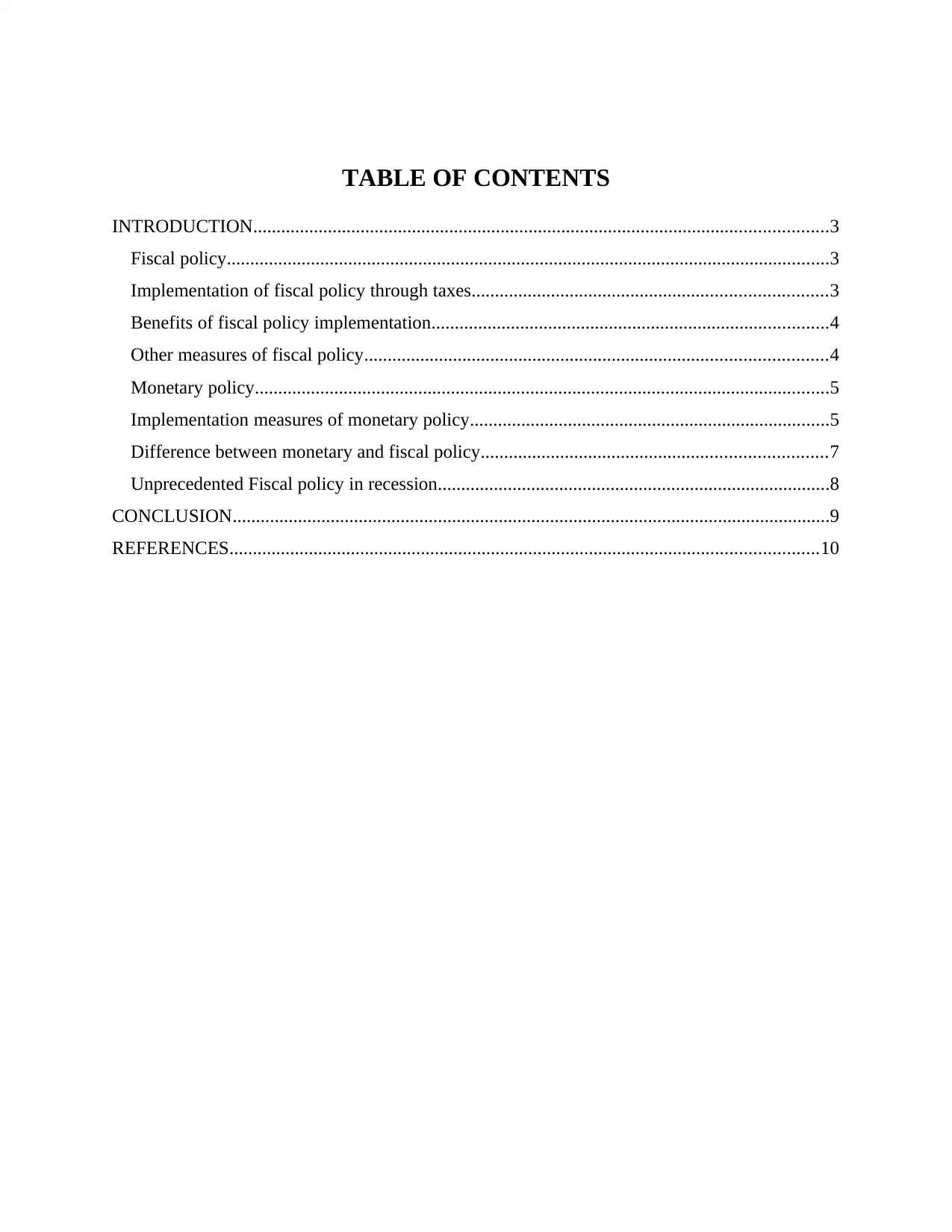
TABLE OF CONTENTS
INTRODUCTION...........................................................................................................................3
Fiscal policy.................................................................................................................................3
Implementation of fiscal policy through taxes............................................................................3
Benefits of fiscal policy implementation.....................................................................................4
Other measures of fiscal policy...................................................................................................4
Monetary policy...........................................................................................................................5
Implementation measures of monetary policy.............................................................................5
Difference between monetary and fiscal policy..........................................................................7
Unprecedented Fiscal policy in recession....................................................................................8
CONCLUSION................................................................................................................................9
REFERENCES..............................................................................................................................10
INTRODUCTION...........................................................................................................................3
Fiscal policy.................................................................................................................................3
Implementation of fiscal policy through taxes............................................................................3
Benefits of fiscal policy implementation.....................................................................................4
Other measures of fiscal policy...................................................................................................4
Monetary policy...........................................................................................................................5
Implementation measures of monetary policy.............................................................................5
Difference between monetary and fiscal policy..........................................................................7
Unprecedented Fiscal policy in recession....................................................................................8
CONCLUSION................................................................................................................................9
REFERENCES..............................................................................................................................10
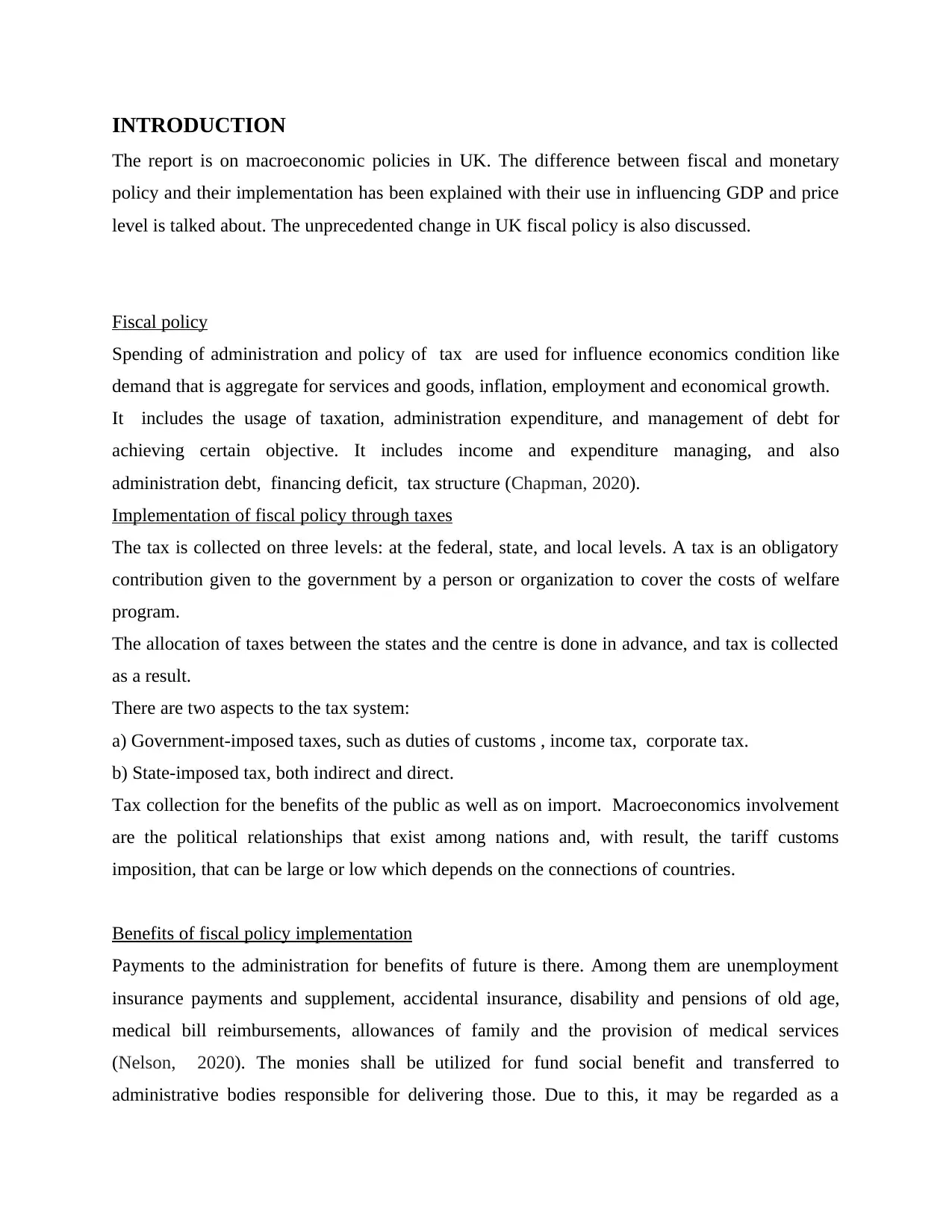
INTRODUCTION
The report is on macroeconomic policies in UK. The difference between fiscal and monetary
policy and their implementation has been explained with their use in influencing GDP and price
level is talked about. The unprecedented change in UK fiscal policy is also discussed.
Fiscal policy
Spending of administration and policy of tax are used for influence economics condition like
demand that is aggregate for services and goods, inflation, employment and economical growth.
It includes the usage of taxation, administration expenditure, and management of debt for
achieving certain objective. It includes income and expenditure managing, and also
administration debt, financing deficit, tax structure (Chapman, 2020).
Implementation of fiscal policy through taxes
The tax is collected on three levels: at the federal, state, and local levels. A tax is an obligatory
contribution given to the government by a person or organization to cover the costs of welfare
program.
The allocation of taxes between the states and the centre is done in advance, and tax is collected
as a result.
There are two aspects to the tax system:
a) Government-imposed taxes, such as duties of customs , income tax, corporate tax.
b) State-imposed tax, both indirect and direct.
Tax collection for the benefits of the public as well as on import. Macroeconomics involvement
are the political relationships that exist among nations and, with result, the tariff customs
imposition, that can be large or low which depends on the connections of countries.
Benefits of fiscal policy implementation
Payments to the administration for benefits of future is there. Among them are unemployment
insurance payments and supplement, accidental insurance, disability and pensions of old age,
medical bill reimbursements, allowances of family and the provision of medical services
(Nelson, 2020). The monies shall be utilized for fund social benefit and transferred to
administrative bodies responsible for delivering those. Due to this, it may be regarded as a
The report is on macroeconomic policies in UK. The difference between fiscal and monetary
policy and their implementation has been explained with their use in influencing GDP and price
level is talked about. The unprecedented change in UK fiscal policy is also discussed.
Fiscal policy
Spending of administration and policy of tax are used for influence economics condition like
demand that is aggregate for services and goods, inflation, employment and economical growth.
It includes the usage of taxation, administration expenditure, and management of debt for
achieving certain objective. It includes income and expenditure managing, and also
administration debt, financing deficit, tax structure (Chapman, 2020).
Implementation of fiscal policy through taxes
The tax is collected on three levels: at the federal, state, and local levels. A tax is an obligatory
contribution given to the government by a person or organization to cover the costs of welfare
program.
The allocation of taxes between the states and the centre is done in advance, and tax is collected
as a result.
There are two aspects to the tax system:
a) Government-imposed taxes, such as duties of customs , income tax, corporate tax.
b) State-imposed tax, both indirect and direct.
Tax collection for the benefits of the public as well as on import. Macroeconomics involvement
are the political relationships that exist among nations and, with result, the tariff customs
imposition, that can be large or low which depends on the connections of countries.
Benefits of fiscal policy implementation
Payments to the administration for benefits of future is there. Among them are unemployment
insurance payments and supplement, accidental insurance, disability and pensions of old age,
medical bill reimbursements, allowances of family and the provision of medical services
(Nelson, 2020). The monies shall be utilized for fund social benefit and transferred to
administrative bodies responsible for delivering those. Due to this, it may be regarded as a
⊘ This is a preview!⊘
Do you want full access?
Subscribe today to unlock all pages.

Trusted by 1+ million students worldwide
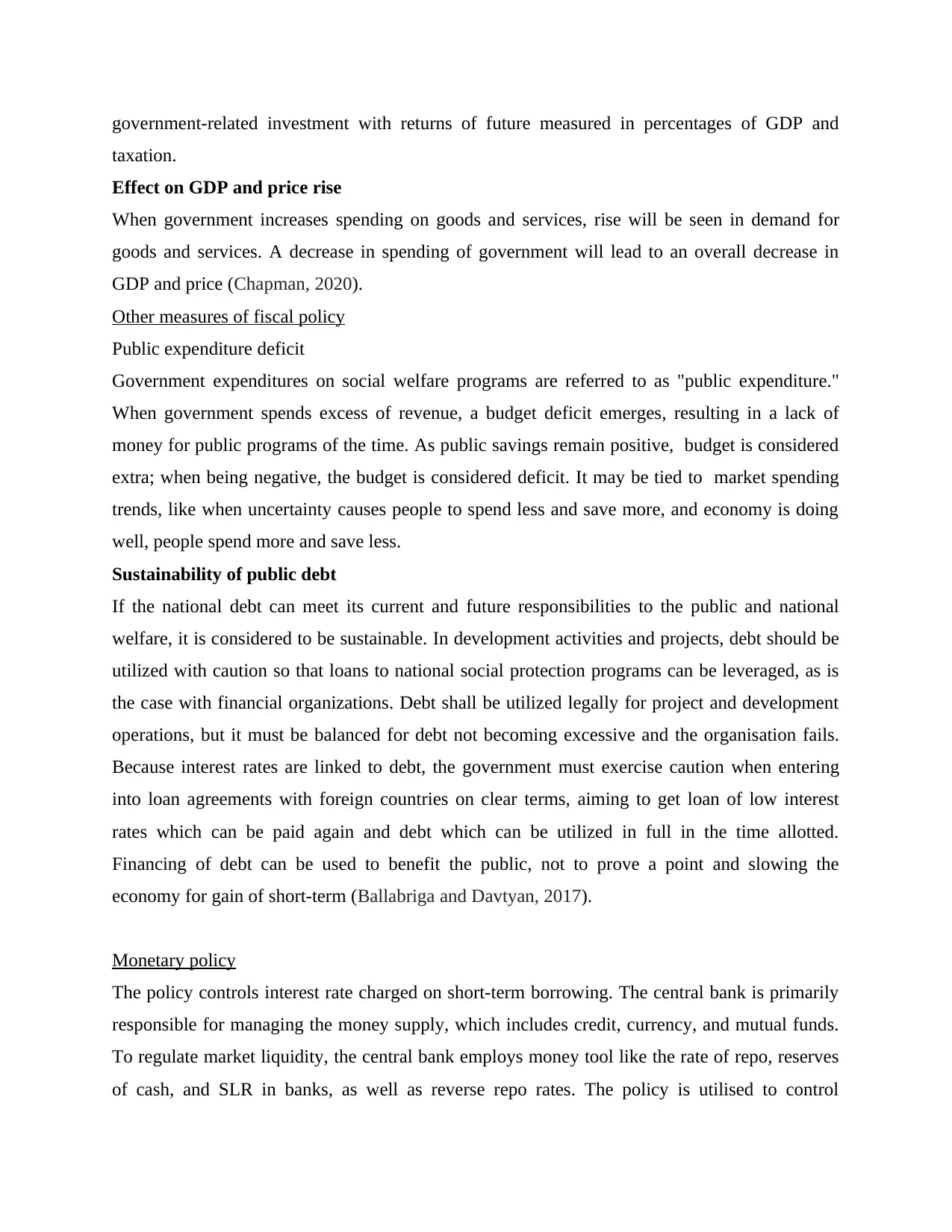
government-related investment with returns of future measured in percentages of GDP and
taxation.
Effect on GDP and price rise
When government increases spending on goods and services, rise will be seen in demand for
goods and services. A decrease in spending of government will lead to an overall decrease in
GDP and price (Chapman, 2020).
Other measures of fiscal policy
Public expenditure deficit
Government expenditures on social welfare programs are referred to as "public expenditure."
When government spends excess of revenue, a budget deficit emerges, resulting in a lack of
money for public programs of the time. As public savings remain positive, budget is considered
extra; when being negative, the budget is considered deficit. It may be tied to market spending
trends, like when uncertainty causes people to spend less and save more, and economy is doing
well, people spend more and save less.
Sustainability of public debt
If the national debt can meet its current and future responsibilities to the public and national
welfare, it is considered to be sustainable. In development activities and projects, debt should be
utilized with caution so that loans to national social protection programs can be leveraged, as is
the case with financial organizations. Debt shall be utilized legally for project and development
operations, but it must be balanced for debt not becoming excessive and the organisation fails.
Because interest rates are linked to debt, the government must exercise caution when entering
into loan agreements with foreign countries on clear terms, aiming to get loan of low interest
rates which can be paid again and debt which can be utilized in full in the time allotted.
Financing of debt can be used to benefit the public, not to prove a point and slowing the
economy for gain of short-term (Ballabriga and Davtyan, 2017).
Monetary policy
The policy controls interest rate charged on short-term borrowing. The central bank is primarily
responsible for managing the money supply, which includes credit, currency, and mutual funds.
To regulate market liquidity, the central bank employs money tool like the rate of repo, reserves
of cash, and SLR in banks, as well as reverse repo rates. The policy is utilised to control
taxation.
Effect on GDP and price rise
When government increases spending on goods and services, rise will be seen in demand for
goods and services. A decrease in spending of government will lead to an overall decrease in
GDP and price (Chapman, 2020).
Other measures of fiscal policy
Public expenditure deficit
Government expenditures on social welfare programs are referred to as "public expenditure."
When government spends excess of revenue, a budget deficit emerges, resulting in a lack of
money for public programs of the time. As public savings remain positive, budget is considered
extra; when being negative, the budget is considered deficit. It may be tied to market spending
trends, like when uncertainty causes people to spend less and save more, and economy is doing
well, people spend more and save less.
Sustainability of public debt
If the national debt can meet its current and future responsibilities to the public and national
welfare, it is considered to be sustainable. In development activities and projects, debt should be
utilized with caution so that loans to national social protection programs can be leveraged, as is
the case with financial organizations. Debt shall be utilized legally for project and development
operations, but it must be balanced for debt not becoming excessive and the organisation fails.
Because interest rates are linked to debt, the government must exercise caution when entering
into loan agreements with foreign countries on clear terms, aiming to get loan of low interest
rates which can be paid again and debt which can be utilized in full in the time allotted.
Financing of debt can be used to benefit the public, not to prove a point and slowing the
economy for gain of short-term (Ballabriga and Davtyan, 2017).
Monetary policy
The policy controls interest rate charged on short-term borrowing. The central bank is primarily
responsible for managing the money supply, which includes credit, currency, and mutual funds.
To regulate market liquidity, the central bank employs money tool like the rate of repo, reserves
of cash, and SLR in banks, as well as reverse repo rates. The policy is utilised to control
Paraphrase This Document
Need a fresh take? Get an instant paraphrase of this document with our AI Paraphraser
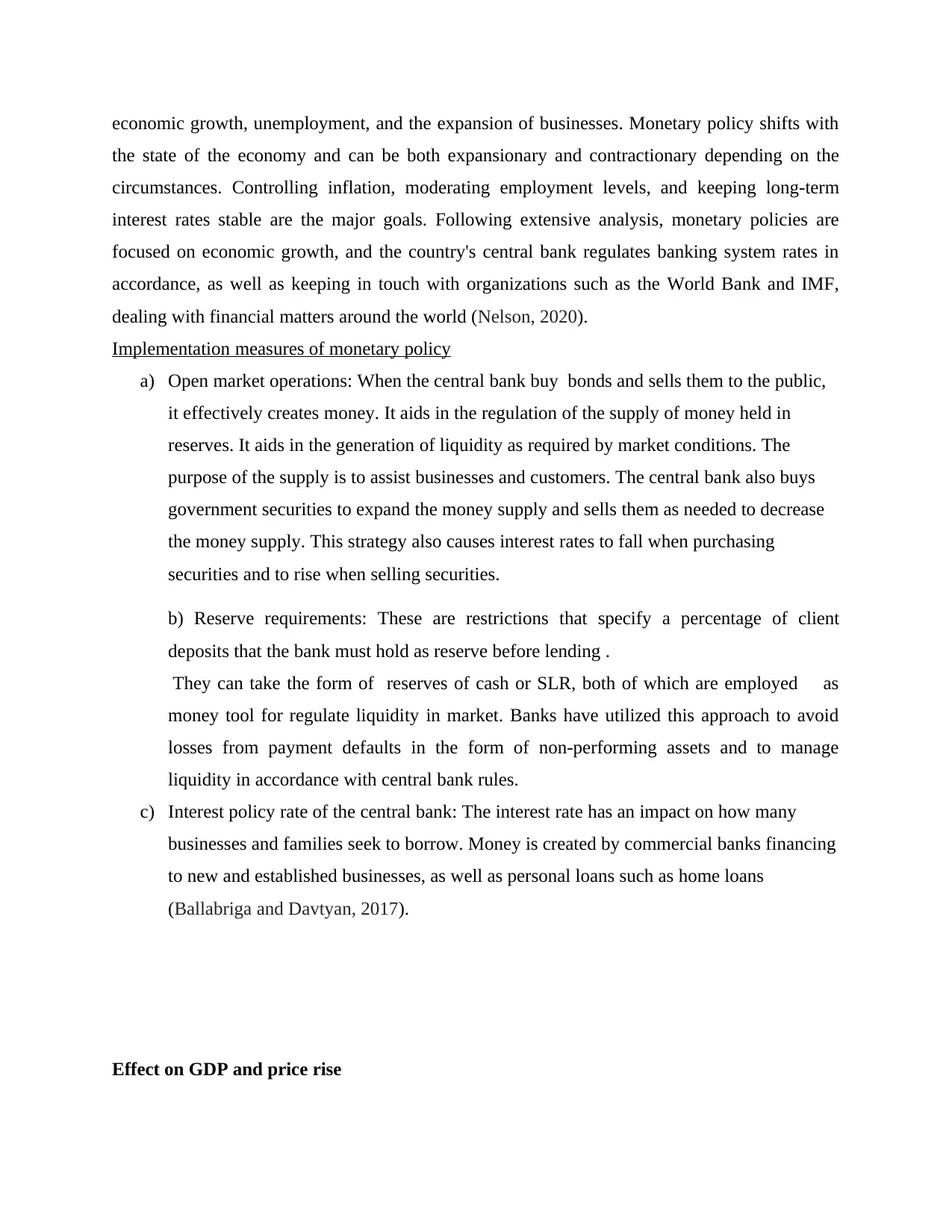
economic growth, unemployment, and the expansion of businesses. Monetary policy shifts with
the state of the economy and can be both expansionary and contractionary depending on the
circumstances. Controlling inflation, moderating employment levels, and keeping long-term
interest rates stable are the major goals. Following extensive analysis, monetary policies are
focused on economic growth, and the country's central bank regulates banking system rates in
accordance, as well as keeping in touch with organizations such as the World Bank and IMF,
dealing with financial matters around the world (Nelson, 2020).
Implementation measures of monetary policy
a) Open market operations: When the central bank buy bonds and sells them to the public,
it effectively creates money. It aids in the regulation of the supply of money held in
reserves. It aids in the generation of liquidity as required by market conditions. The
purpose of the supply is to assist businesses and customers. The central bank also buys
government securities to expand the money supply and sells them as needed to decrease
the money supply. This strategy also causes interest rates to fall when purchasing
securities and to rise when selling securities.
b) Reserve requirements: These are restrictions that specify a percentage of client
deposits that the bank must hold as reserve before lending .
They can take the form of reserves of cash or SLR, both of which are employed as
money tool for regulate liquidity in market. Banks have utilized this approach to avoid
losses from payment defaults in the form of non-performing assets and to manage
liquidity in accordance with central bank rules.
c) Interest policy rate of the central bank: The interest rate has an impact on how many
businesses and families seek to borrow. Money is created by commercial banks financing
to new and established businesses, as well as personal loans such as home loans
(Ballabriga and Davtyan, 2017).
Effect on GDP and price rise
the state of the economy and can be both expansionary and contractionary depending on the
circumstances. Controlling inflation, moderating employment levels, and keeping long-term
interest rates stable are the major goals. Following extensive analysis, monetary policies are
focused on economic growth, and the country's central bank regulates banking system rates in
accordance, as well as keeping in touch with organizations such as the World Bank and IMF,
dealing with financial matters around the world (Nelson, 2020).
Implementation measures of monetary policy
a) Open market operations: When the central bank buy bonds and sells them to the public,
it effectively creates money. It aids in the regulation of the supply of money held in
reserves. It aids in the generation of liquidity as required by market conditions. The
purpose of the supply is to assist businesses and customers. The central bank also buys
government securities to expand the money supply and sells them as needed to decrease
the money supply. This strategy also causes interest rates to fall when purchasing
securities and to rise when selling securities.
b) Reserve requirements: These are restrictions that specify a percentage of client
deposits that the bank must hold as reserve before lending .
They can take the form of reserves of cash or SLR, both of which are employed as
money tool for regulate liquidity in market. Banks have utilized this approach to avoid
losses from payment defaults in the form of non-performing assets and to manage
liquidity in accordance with central bank rules.
c) Interest policy rate of the central bank: The interest rate has an impact on how many
businesses and families seek to borrow. Money is created by commercial banks financing
to new and established businesses, as well as personal loans such as home loans
(Ballabriga and Davtyan, 2017).
Effect on GDP and price rise
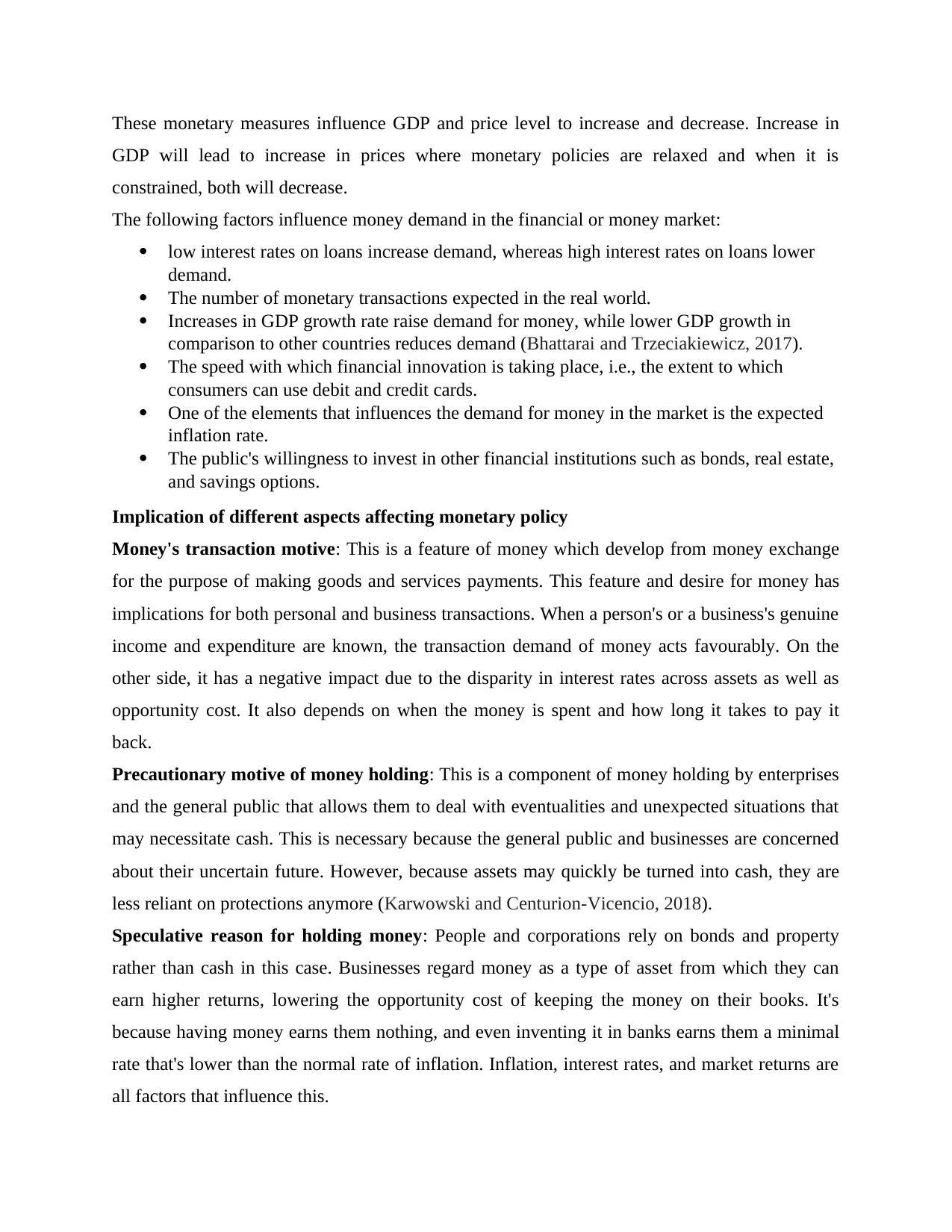
These monetary measures influence GDP and price level to increase and decrease. Increase in
GDP will lead to increase in prices where monetary policies are relaxed and when it is
constrained, both will decrease.
The following factors influence money demand in the financial or money market:
low interest rates on loans increase demand, whereas high interest rates on loans lower
demand.
The number of monetary transactions expected in the real world.
Increases in GDP growth rate raise demand for money, while lower GDP growth in
comparison to other countries reduces demand (Bhattarai and Trzeciakiewicz, 2017).
The speed with which financial innovation is taking place, i.e., the extent to which
consumers can use debit and credit cards.
One of the elements that influences the demand for money in the market is the expected
inflation rate.
The public's willingness to invest in other financial institutions such as bonds, real estate,
and savings options.
Implication of different aspects affecting monetary policy
Money's transaction motive: This is a feature of money which develop from money exchange
for the purpose of making goods and services payments. This feature and desire for money has
implications for both personal and business transactions. When a person's or a business's genuine
income and expenditure are known, the transaction demand of money acts favourably. On the
other side, it has a negative impact due to the disparity in interest rates across assets as well as
opportunity cost. It also depends on when the money is spent and how long it takes to pay it
back.
Precautionary motive of money holding: This is a component of money holding by enterprises
and the general public that allows them to deal with eventualities and unexpected situations that
may necessitate cash. This is necessary because the general public and businesses are concerned
about their uncertain future. However, because assets may quickly be turned into cash, they are
less reliant on protections anymore (Karwowski and Centurion-Vicencio, 2018).
Speculative reason for holding money: People and corporations rely on bonds and property
rather than cash in this case. Businesses regard money as a type of asset from which they can
earn higher returns, lowering the opportunity cost of keeping the money on their books. It's
because having money earns them nothing, and even inventing it in banks earns them a minimal
rate that's lower than the normal rate of inflation. Inflation, interest rates, and market returns are
all factors that influence this.
GDP will lead to increase in prices where monetary policies are relaxed and when it is
constrained, both will decrease.
The following factors influence money demand in the financial or money market:
low interest rates on loans increase demand, whereas high interest rates on loans lower
demand.
The number of monetary transactions expected in the real world.
Increases in GDP growth rate raise demand for money, while lower GDP growth in
comparison to other countries reduces demand (Bhattarai and Trzeciakiewicz, 2017).
The speed with which financial innovation is taking place, i.e., the extent to which
consumers can use debit and credit cards.
One of the elements that influences the demand for money in the market is the expected
inflation rate.
The public's willingness to invest in other financial institutions such as bonds, real estate,
and savings options.
Implication of different aspects affecting monetary policy
Money's transaction motive: This is a feature of money which develop from money exchange
for the purpose of making goods and services payments. This feature and desire for money has
implications for both personal and business transactions. When a person's or a business's genuine
income and expenditure are known, the transaction demand of money acts favourably. On the
other side, it has a negative impact due to the disparity in interest rates across assets as well as
opportunity cost. It also depends on when the money is spent and how long it takes to pay it
back.
Precautionary motive of money holding: This is a component of money holding by enterprises
and the general public that allows them to deal with eventualities and unexpected situations that
may necessitate cash. This is necessary because the general public and businesses are concerned
about their uncertain future. However, because assets may quickly be turned into cash, they are
less reliant on protections anymore (Karwowski and Centurion-Vicencio, 2018).
Speculative reason for holding money: People and corporations rely on bonds and property
rather than cash in this case. Businesses regard money as a type of asset from which they can
earn higher returns, lowering the opportunity cost of keeping the money on their books. It's
because having money earns them nothing, and even inventing it in banks earns them a minimal
rate that's lower than the normal rate of inflation. Inflation, interest rates, and market returns are
all factors that influence this.
⊘ This is a preview!⊘
Do you want full access?
Subscribe today to unlock all pages.

Trusted by 1+ million students worldwide
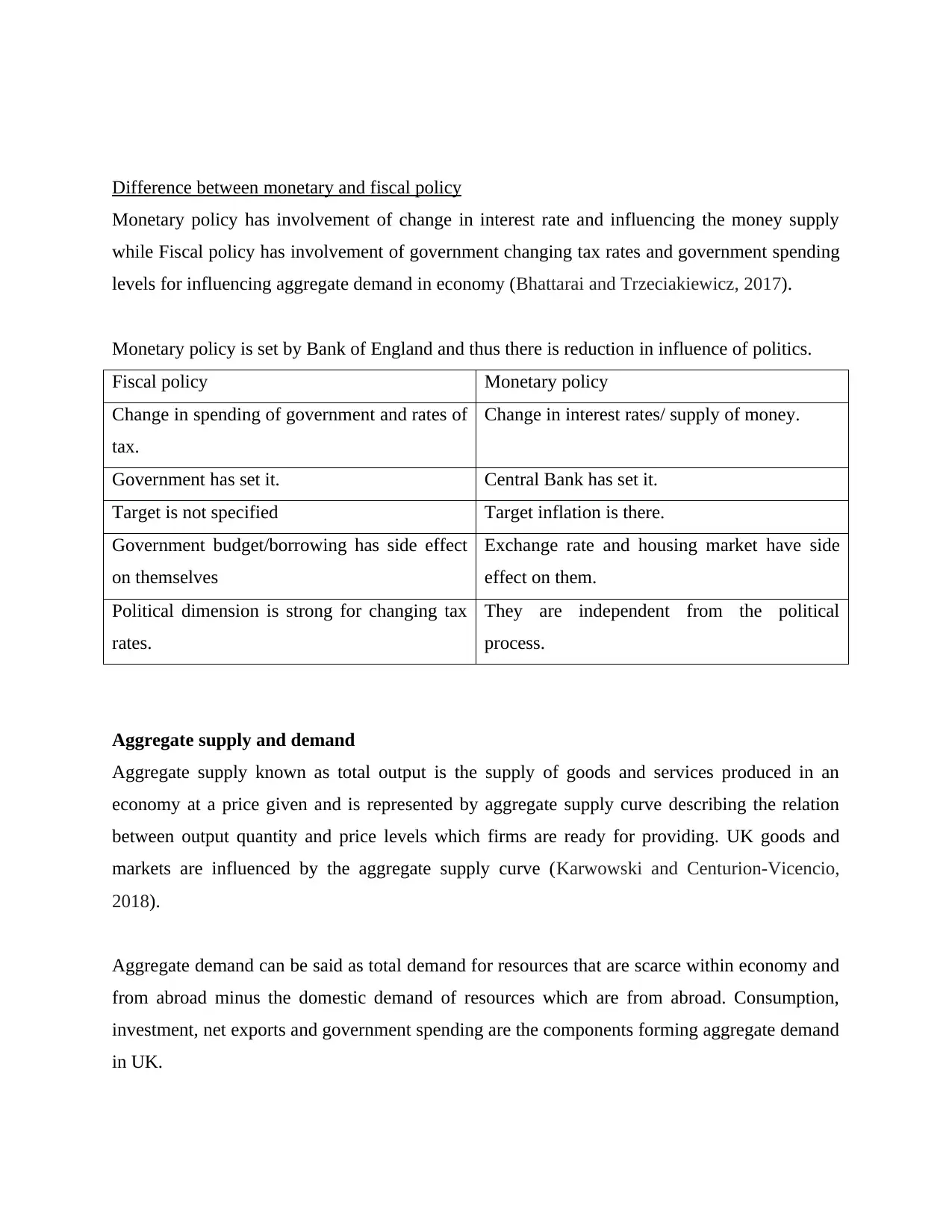
Difference between monetary and fiscal policy
Monetary policy has involvement of change in interest rate and influencing the money supply
while Fiscal policy has involvement of government changing tax rates and government spending
levels for influencing aggregate demand in economy (Bhattarai and Trzeciakiewicz, 2017).
Monetary policy is set by Bank of England and thus there is reduction in influence of politics.
Fiscal policy Monetary policy
Change in spending of government and rates of
tax.
Change in interest rates/ supply of money.
Government has set it. Central Bank has set it.
Target is not specified Target inflation is there.
Government budget/borrowing has side effect
on themselves
Exchange rate and housing market have side
effect on them.
Political dimension is strong for changing tax
rates.
They are independent from the political
process.
Aggregate supply and demand
Aggregate supply known as total output is the supply of goods and services produced in an
economy at a price given and is represented by aggregate supply curve describing the relation
between output quantity and price levels which firms are ready for providing. UK goods and
markets are influenced by the aggregate supply curve (Karwowski and Centurion-Vicencio,
2018).
Aggregate demand can be said as total demand for resources that are scarce within economy and
from abroad minus the domestic demand of resources which are from abroad. Consumption,
investment, net exports and government spending are the components forming aggregate demand
in UK.
Monetary policy has involvement of change in interest rate and influencing the money supply
while Fiscal policy has involvement of government changing tax rates and government spending
levels for influencing aggregate demand in economy (Bhattarai and Trzeciakiewicz, 2017).
Monetary policy is set by Bank of England and thus there is reduction in influence of politics.
Fiscal policy Monetary policy
Change in spending of government and rates of
tax.
Change in interest rates/ supply of money.
Government has set it. Central Bank has set it.
Target is not specified Target inflation is there.
Government budget/borrowing has side effect
on themselves
Exchange rate and housing market have side
effect on them.
Political dimension is strong for changing tax
rates.
They are independent from the political
process.
Aggregate supply and demand
Aggregate supply known as total output is the supply of goods and services produced in an
economy at a price given and is represented by aggregate supply curve describing the relation
between output quantity and price levels which firms are ready for providing. UK goods and
markets are influenced by the aggregate supply curve (Karwowski and Centurion-Vicencio,
2018).
Aggregate demand can be said as total demand for resources that are scarce within economy and
from abroad minus the domestic demand of resources which are from abroad. Consumption,
investment, net exports and government spending are the components forming aggregate demand
in UK.
Paraphrase This Document
Need a fresh take? Get an instant paraphrase of this document with our AI Paraphraser
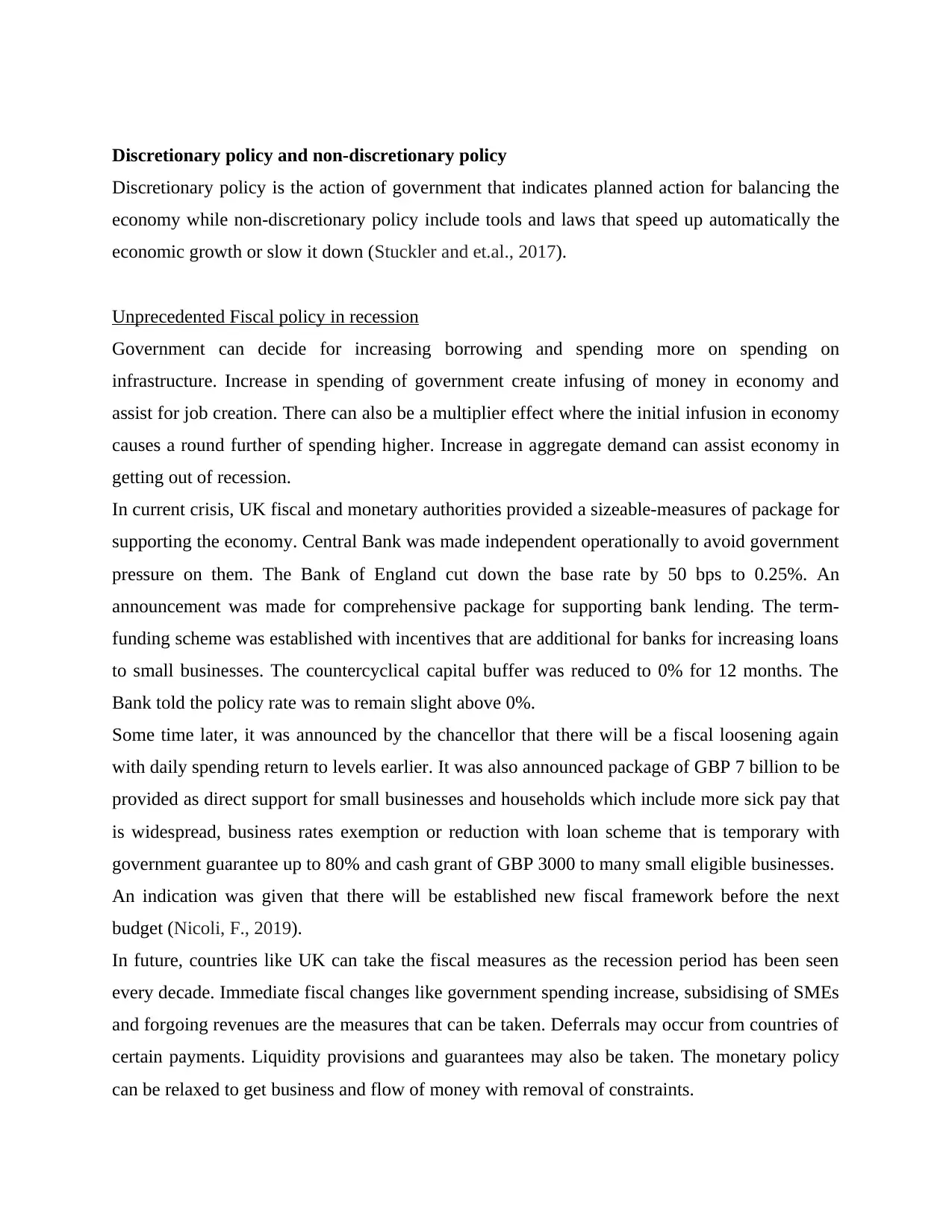
Discretionary policy and non-discretionary policy
Discretionary policy is the action of government that indicates planned action for balancing the
economy while non-discretionary policy include tools and laws that speed up automatically the
economic growth or slow it down (Stuckler and et.al., 2017).
Unprecedented Fiscal policy in recession
Government can decide for increasing borrowing and spending more on spending on
infrastructure. Increase in spending of government create infusing of money in economy and
assist for job creation. There can also be a multiplier effect where the initial infusion in economy
causes a round further of spending higher. Increase in aggregate demand can assist economy in
getting out of recession.
In current crisis, UK fiscal and monetary authorities provided a sizeable-measures of package for
supporting the economy. Central Bank was made independent operationally to avoid government
pressure on them. The Bank of England cut down the base rate by 50 bps to 0.25%. An
announcement was made for comprehensive package for supporting bank lending. The term-
funding scheme was established with incentives that are additional for banks for increasing loans
to small businesses. The countercyclical capital buffer was reduced to 0% for 12 months. The
Bank told the policy rate was to remain slight above 0%.
Some time later, it was announced by the chancellor that there will be a fiscal loosening again
with daily spending return to levels earlier. It was also announced package of GBP 7 billion to be
provided as direct support for small businesses and households which include more sick pay that
is widespread, business rates exemption or reduction with loan scheme that is temporary with
government guarantee up to 80% and cash grant of GBP 3000 to many small eligible businesses.
An indication was given that there will be established new fiscal framework before the next
budget (Nicoli, F., 2019).
In future, countries like UK can take the fiscal measures as the recession period has been seen
every decade. Immediate fiscal changes like government spending increase, subsidising of SMEs
and forgoing revenues are the measures that can be taken. Deferrals may occur from countries of
certain payments. Liquidity provisions and guarantees may also be taken. The monetary policy
can be relaxed to get business and flow of money with removal of constraints.
Discretionary policy is the action of government that indicates planned action for balancing the
economy while non-discretionary policy include tools and laws that speed up automatically the
economic growth or slow it down (Stuckler and et.al., 2017).
Unprecedented Fiscal policy in recession
Government can decide for increasing borrowing and spending more on spending on
infrastructure. Increase in spending of government create infusing of money in economy and
assist for job creation. There can also be a multiplier effect where the initial infusion in economy
causes a round further of spending higher. Increase in aggregate demand can assist economy in
getting out of recession.
In current crisis, UK fiscal and monetary authorities provided a sizeable-measures of package for
supporting the economy. Central Bank was made independent operationally to avoid government
pressure on them. The Bank of England cut down the base rate by 50 bps to 0.25%. An
announcement was made for comprehensive package for supporting bank lending. The term-
funding scheme was established with incentives that are additional for banks for increasing loans
to small businesses. The countercyclical capital buffer was reduced to 0% for 12 months. The
Bank told the policy rate was to remain slight above 0%.
Some time later, it was announced by the chancellor that there will be a fiscal loosening again
with daily spending return to levels earlier. It was also announced package of GBP 7 billion to be
provided as direct support for small businesses and households which include more sick pay that
is widespread, business rates exemption or reduction with loan scheme that is temporary with
government guarantee up to 80% and cash grant of GBP 3000 to many small eligible businesses.
An indication was given that there will be established new fiscal framework before the next
budget (Nicoli, F., 2019).
In future, countries like UK can take the fiscal measures as the recession period has been seen
every decade. Immediate fiscal changes like government spending increase, subsidising of SMEs
and forgoing revenues are the measures that can be taken. Deferrals may occur from countries of
certain payments. Liquidity provisions and guarantees may also be taken. The monetary policy
can be relaxed to get business and flow of money with removal of constraints.
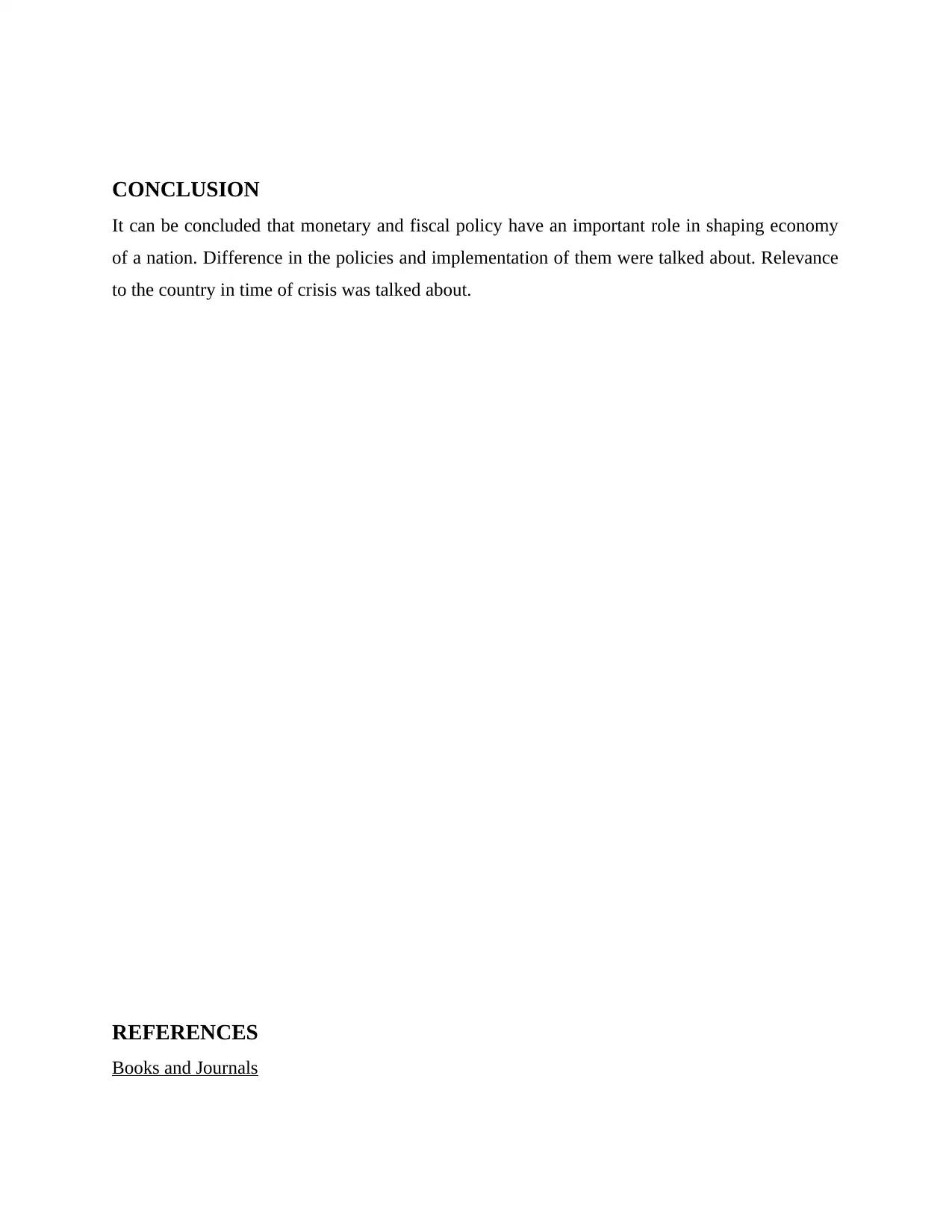
CONCLUSION
It can be concluded that monetary and fiscal policy have an important role in shaping economy
of a nation. Difference in the policies and implementation of them were talked about. Relevance
to the country in time of crisis was talked about.
REFERENCES
Books and Journals
It can be concluded that monetary and fiscal policy have an important role in shaping economy
of a nation. Difference in the policies and implementation of them were talked about. Relevance
to the country in time of crisis was talked about.
REFERENCES
Books and Journals
⊘ This is a preview!⊘
Do you want full access?
Subscribe today to unlock all pages.

Trusted by 1+ million students worldwide
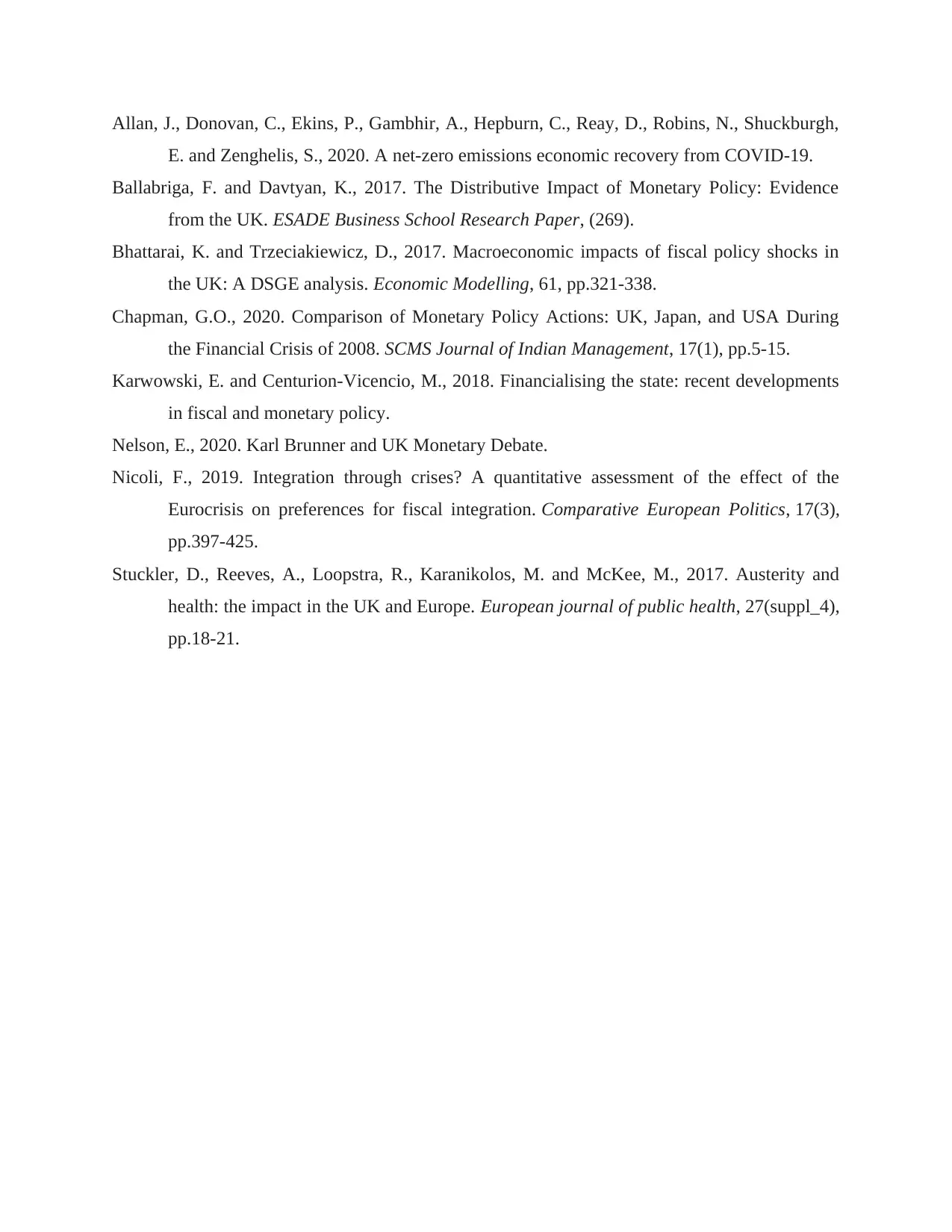
Allan, J., Donovan, C., Ekins, P., Gambhir, A., Hepburn, C., Reay, D., Robins, N., Shuckburgh,
E. and Zenghelis, S., 2020. A net-zero emissions economic recovery from COVID-19.
Ballabriga, F. and Davtyan, K., 2017. The Distributive Impact of Monetary Policy: Evidence
from the UK. ESADE Business School Research Paper, (269).
Bhattarai, K. and Trzeciakiewicz, D., 2017. Macroeconomic impacts of fiscal policy shocks in
the UK: A DSGE analysis. Economic Modelling, 61, pp.321-338.
Chapman, G.O., 2020. Comparison of Monetary Policy Actions: UK, Japan, and USA During
the Financial Crisis of 2008. SCMS Journal of Indian Management, 17(1), pp.5-15.
Karwowski, E. and Centurion-Vicencio, M., 2018. Financialising the state: recent developments
in fiscal and monetary policy.
Nelson, E., 2020. Karl Brunner and UK Monetary Debate.
Nicoli, F., 2019. Integration through crises? A quantitative assessment of the effect of the
Eurocrisis on preferences for fiscal integration. Comparative European Politics, 17(3),
pp.397-425.
Stuckler, D., Reeves, A., Loopstra, R., Karanikolos, M. and McKee, M., 2017. Austerity and
health: the impact in the UK and Europe. European journal of public health, 27(suppl_4),
pp.18-21.
E. and Zenghelis, S., 2020. A net-zero emissions economic recovery from COVID-19.
Ballabriga, F. and Davtyan, K., 2017. The Distributive Impact of Monetary Policy: Evidence
from the UK. ESADE Business School Research Paper, (269).
Bhattarai, K. and Trzeciakiewicz, D., 2017. Macroeconomic impacts of fiscal policy shocks in
the UK: A DSGE analysis. Economic Modelling, 61, pp.321-338.
Chapman, G.O., 2020. Comparison of Monetary Policy Actions: UK, Japan, and USA During
the Financial Crisis of 2008. SCMS Journal of Indian Management, 17(1), pp.5-15.
Karwowski, E. and Centurion-Vicencio, M., 2018. Financialising the state: recent developments
in fiscal and monetary policy.
Nelson, E., 2020. Karl Brunner and UK Monetary Debate.
Nicoli, F., 2019. Integration through crises? A quantitative assessment of the effect of the
Eurocrisis on preferences for fiscal integration. Comparative European Politics, 17(3),
pp.397-425.
Stuckler, D., Reeves, A., Loopstra, R., Karanikolos, M. and McKee, M., 2017. Austerity and
health: the impact in the UK and Europe. European journal of public health, 27(suppl_4),
pp.18-21.
Paraphrase This Document
Need a fresh take? Get an instant paraphrase of this document with our AI Paraphraser


⊘ This is a preview!⊘
Do you want full access?
Subscribe today to unlock all pages.

Trusted by 1+ million students worldwide
1 out of 19
Related Documents
Your All-in-One AI-Powered Toolkit for Academic Success.
+13062052269
info@desklib.com
Available 24*7 on WhatsApp / Email
![[object Object]](/_next/static/media/star-bottom.7253800d.svg)
Unlock your academic potential
Copyright © 2020–2025 A2Z Services. All Rights Reserved. Developed and managed by ZUCOL.





